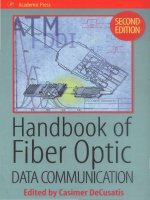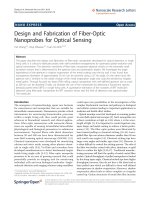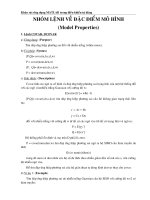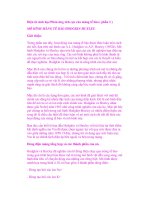Overview of Fiber Optic Sensors phần 3 ppsx
Bạn đang xem bản rút gọn của tài liệu. Xem và tải ngay bản đầy đủ của tài liệu tại đây (43.3 KB, 10 trang )
Figure 32 shows the basic elements of a Mach-Zehnder interferometer, which are a light
source/coupler module, a transducer and a homodyne demodulator. The light source
module usually consists of a long coherence length isolated laser diode, a beam splitter to
produce two light beams and a means of coupling the beams to the two legs of the
transducer. The transducer is configured to sense an environmental effect by isolating one
light beam from the environmental effect and using the action of the environmental effect
on the transducer is to induce an optical path length difference between the two light
beams. Typically a homodyne demodulator is used to detect the difference in optical path
length (various heterodyne schemes have also been used). [43].
φ
Light Source/Coupler Module
Transducer
Homodyne Demodulator
Figure 32. The basic elements of the fiber optic Mach-Zehnder interferometer are a light source module
to split a light beam into two paths, a transducer used to cause an environmentally dependent differential
optical path length between the two light beams, and a demodulator that measures the resulting path
length difference between the two light beams.
One of the basic issues with the Mach-Zehnder interferometer is that the sensitivity will
vary as a function of the relative phase of the light beams in the two legs of the
interferometer, as shown in Figure 33. One way to solve the signal fading problem is to
introduce a piezoelectric fiber stretcher into one of the legs and adjust the relative path
length of the two legs for optimum sensitivity. Another approach has the same quadrature
solution as the grating based fiber sensors discussed earlier.
Relative Phase
Intensity
Figure 33. In the absence of compensating demodulation methods the sensitivity of the Mach-Zehnder
varies with the relative phase between the two light beams. It falls to low levels when the light beams are
completely in or out of phase.
Figure 34 illustrates a homodyne demodulator. The demodulator consists of two parallel
optical fibers that feed the light beams from the transducer into a graded index (GRIN)
lens. The output from the graded index lens is an interference pattern that “rolls” with the
relative phase of the two input light beams. If a split detector is used with a photomask
arranged so that the opaque and transparent line pairs on the mask in front of the split
detector match the interference pattern periodicity and are 90 degrees out of phase on the
detector faces, sine and cosine outputs result.
Dual Input
Fibers
GRIN Lens
Interference
Pattern
Split Photomasked
Detector, Sine and
Cosine Outputs
Figure 34. Quadrature demodulation avoids signal fading problems. The method shown here expands the
two beams into an interference pattern that is imaged onto a split detector.
These outputs may be processed using quadrature demodulation electronics as shown in
Figure 35. The result is a direct measure of the phase difference.
sin
φ
cos
φ
φ
d
φ/
dtx
x
D
D
Differentiator Multiplier
Integrator
Difference
Amplifier
(d
φ/
dt)cos
2
φ
-(d
φ/
dt)sin
2
φ
Figure 35. Quadrature demodulation electronics take the sinusoidal outputs from the split detector and
convert them via cross multiplication and differentiation into an output that can be integrated to form the
direct phase difference.
Further improvements on these techniques have been made; notably the phase generated
carrier approach shown in Figure 36. A laser diode is current modulated resulting in the
output frequency of the laser diode being frequency modulated as well. If a Mach-
Zehnder interferometer is arranged so that its reference and signal leg differ in length by an
amount (L
1
-L
2
) then the net phase difference between the two light beams is 2πF(L
1
-
L
2
)n/c, where n is the index of refraction of the optical fiber and c is the speed of light in
vacuum. If the current modulation is at a rate ωthen relative phase differences are
modulated at this rate and the output on the detector will be odd and even harmonics of it.
The signals riding on the carrier harmonics of ωand 2ωare in quadrature with respect to
each other and can be processed using electronics similar to those of Figure 35.
Light Source
Current Driver
ω
ω, 2ω
Output
L
1
L
2
F(L
1
-L
2
)n/c
Figure 36. The phase generated carrier technique allows quadrature detection via monitoring even and
odd harmonics induced by a sinusoidally frequency modulated light source used in combination with a
length offset Mach-Zehnder interferometer to generate a modulated phase output whose first and second
harmonics correspond to sine and cosine outputs.
The Michelson interferometer shown in Figure 37 is in many respects similar to the Mach-
Zehnder. The major difference is that mirrors have been put on the ends of the
interferometer legs. This results in very high levels of back reflection into the light source
greatly degrading the performance of early systems. By using improved diode pumped
YAG (Yttrium Aluminum Garnet) ring lasers as light sources these problems have been
largely overcome. In combination with the recent introduction of phase conjugate mirrors
to eliminate polarization fading, the Michelson is becoming an alternative for systems that
can tolerate the relatively high present cost of these components.
L
1
L
2Detector
Light Source
Coupler
Mirrors
Figure 37. The fiber optic Michelson interferometer consists of two mirrored fiber ends and can utilize
many of the demodulation methods and techniques associated with the Mach-Zehnder.
In order to implement an effective Mach-Zehnder or Michelson based fiber sensor it is
necessary to construct an appropriate transducer. This can involve a fiber coating that
could be optimized for acoustic, electric or magnetic field response. In Figure 38 a two
part coating is illustrated that consists of a primary and secondary layer. These layers are
designed for optimal response to pressure waves and for minimal acoustic mismatches
between the medium in which the pressure waves propagate and the optical fiber.
Glass Fiber
Primary
Coating
Secondary
Compliant
Coating
Pressure
Figure 38. Coatings can be used to optimize the sensitivity of fiber sensors. An example would be to use
soft and hard coatings over an optical fiber to minimize the acoustic mismatch between acoustic pressure
waves in water and the glass optical fiber.
These coated fibers are often used in combination with compliant mandrills or strips of
material as in Figure 39 that act to amplify the environmentally induced optical path length
difference.
Strip
Hollow Mandrill
Figure 39. Optical fiber bonded to hollow mandrills and strips of environmentally sensitive material are
common methods used to mechanically amplify environmental signals for detection by fiber sensors.
In many cases the mechanical details of the transducer design are critical to good
performance such as the seismic/vibration sensor of Figure 40. Generally the Mach-
Zehnder and Michelson interferometers can be configured with sensitivities that are better
than 10
-6
radians per square root Hertz. For optical receivers, the noise level decreases as
a function of frequency. This phenomenon results in specifications in radians per square
root Hertz. As an example, a sensitivity of 10
-6
radians per square root Hertz at 1 Hertz
means a sensitivity of 10
-6
radians while at 100 Hertz, the sensitivity is 10
-7
radians. As an
example, a sensitivity of 10
-6
radian per square root Hertz means that for a 1 meter long
transducer, less than 1/6 micron of length change can be resolved at 1 Hertz bandwidths.
[44]. The best performance for these sensors is usually achieved at higher frequencies
because of problems associated with the sensors also picking up environmental signals due
to temperature fluctuations, vibrations and acoustics that limit useful low frequency
sensitivity.
Fiber
Coil
Seismic
Mass
Soft
Rubber
Mandril
Figure 40. Differential methods are used to amplify environmental signals. In this case a
seismic/vibration sensor consists of a mass placed between two fiber coils and encased in a fixed housing.
Multiplexing and Distributed Sensing
Many of the intrinsic and extrinsic sensors may be multiplexed [45] offering the possibility
of large numbers of sensors being supported by a single fiber optic line. The techniques
that are most commonly employed are time, frequency, wavelength, coherence,
polarization and spatial multiplexing.
Time division multiplexing employs a pulsed light source launching light into an optical
fiber and analyzing the time delay to discriminate between sensors. This technique is
commonly employed to support distributed sensors where measurements of strain,
temperature or other parameters are collected. Figure 41 illustrates a time division
multiplexed system that uses microbend sensitive areas on pipe joints.
Pipe Joints
Light
Source
Detector
Signal
Processing
Electronics
Microbend
Fiber
Attachment
Figure 41. Time division multiplexing methods can be used in combination with microbend sensitive
optical fiber to locate the position of stress along a pipeline.
As the pipe joints are stressed microbending loss increases and the time delay associated
with these losses allows the location of faulty joints.
The entire length of the fiber can be made microbend sensitive and Rayleigh scattering loss
used to support a distributed sensor that will predominantly measure strain. Other types
of scattering from optical pulses propagating down optical fiber have been used to support
distributed sensing, notably Raman scattering for temperature sensors has been made into
a commercial product by York Technology and Hitachi. These units can resolve
temperature changes of about 1 degree C with spatial resolution of 1 meter for a 1 km
sensor using an integration time of about 5 minutes. Brillioun scattering has been used in
laboratory experiments to support both strain and temperature measurements.
A frequency division multiplexed system is shown in Figure 42. In this example a laser
diode is frequency chirped by driving it with a sawtooth current drive. Successive Mach-
Zehnder interferometers are offset with incremental lengths (L-L
1
), (L-L
2
), and (L-L
3
)
which differ sufficiently that the resultant carrier frequency of each sensor (dF/dt)(L-L
n
) is
easily separable from the other sensors via electronic filtering of the output of the
detector.
L
1
L
2
L
3
L L L
F
2
F
1
F
3
Frequency
Chirped
Light
Source
Detector
Figure 42. Frequency division multiplexing can be used to tag a series of fiber sensors, as in this case the
Mach-Zehnder interferometers are shown with a carrier frequency on which the output signal ride.
Wavelength division multiplexing is one of the best methods of multiplexing as it uses
optical power very efficiently. It also has the advantage of being easily integrated into
other multiplexing systems allowing the possibility of large numbers of sensors being
supported in a single fiber line. Figure 43 illustrates a system where a broadband light
source, such as a light emitting diode, is coupled into a series of fiber sensors that reflect
signals over wavelength bands that are subsets of the light source spectrum. A dispersive
element, such as a grating or prism, is used to separate out the signals from the sensors
onto separate detectors.
λ
1
λ
1
λ
2
λ
3
λ
4
λ
2
λ
3
λ
4
Wavelength Division
Multiplexer/Detectors
Light
Source
Figure 43. Wavelength division multiplexing are often very energy efficient. A series of fiber sensors are
multiplexed by being arranged to reflect in a particular spectral band that is split via a dispersive element
onto separate detectors.
Light sources can have widely varying coherence lengths depending on their spectrum. By
using light sources that have coherence lengths that are short compared to offsets between
the reference and signal legs in Mach-Zehnder interferometers and between successive
sensors, a coherence multiplexed system similar to Figure 44 may be set up. The signal is
extracted by putting a rebalancing interferometer in front of each detector so that the
sensor signals may be processed. Coherence multiplexing is not as commonly used as
time, frequency and wavelength division multiplexing because of optical power budgets
and the additional complexities in setting up the optics properly. It is still a potentially
powerful technique and may become more widely used as optical component performance
and availability continue to improve, especially in the area of integrated optic chips where
control of optical pathlength differences is relatively straightforward.
L
L
L
L
L
1
L
1
L
2
L
2
Light Source
Detector 2
Detector 1
Figure 44. A low coherence light source is used to multiplex two Mach-Zehnder interferometers by using
offset lengths and counterbalancing interferometers.
One of the least commonly used techniques is polarization multiplexing. In this case the
idea is to launch light with particular polarization states and extract each state. A possible
application is shown in Figure 45 where light is launched with two orthogonal polarization
modes; preserving fiber and evanescent sensors have been set up along each of the axes.
A polarizing beamsplitter is used to separate out the two signals. There is a recent interest
in using polarization preserving fiber in combination with time domain techniques to form
polarization based distributed fiber sensors. This has potential to offer multiple sensing
parameters along a single fiber line.
Polarization
States
Evanescent
Sensors
Detector 1
Detector 2
Light
Source
Polarizing Beamsplitter
Figure 45. Polarization multiplexing is used to support two fiber sensors that access the cross polarization
states of polarization preserving optical fiber.
Finally, it is possible to use spatial techniques to generate large sensor arrays using
relatively few input and output optical fibers. Figure 46 shows a 2 by 2 array of sensors
where two light sources are amplitude modulated at different frequencies. Two sensors
are driven at one frequency and two more at the second. The signals from the sensors are
put onto two output fibers each carrying a sensor signal from two sensors at different
frequencies.
S
4
S
3
S
2
S
1
ω
1
ω
2
S
1
(
ω
1
),
S
3
(
ω
2
)
S
2
(
ω
1
),
S
4
(
ω
2
)
Unbalanced
Interferometers
Light
Sources
Detectors
Figure 46. Spatial multiplexing of four fiber optic sensors may be accomplished by operating two light
sources with different carrier frequencies and cross coupling the sensor outputs onto two output fibers.
This sort of multiplexing is easily extended to ‘m’ input fibers and ‘n’ output fibers to form
‘m’ by ‘n’ arrays of sensors as in Figure 47.
ω
1
ω
2
ω
3
ω
J
1 2 3 K
11
JK
1K
J1
Sources
Detectors
Figure 47. Extensions of spatial multiplexing the JK sensors can be accomplished by operating J light
sources at J different frequencies and cross coupling to K output fibers.
All of these multiplexing techniques can be used in combination with one another to form
extremely large arrays.
Applications
Fiber optic sensors are being developed and used in two major ways. The first is as a
direct replacement for existing sensors where the fiber sensor offers significantly improved
performance, reliability, safety and/or cost advantages to the end user. The second area is
the development and deployment of fiber optic sensors in new market areas.
For the case of direct replacement, the inherent value of the fiber sensor, to the
customer, has to be sufficiently high to displace older technology. Because this often
involves replacing technology the customer is familiar with, the improvements must be
substantial.
The most obvious example of a fiber optic sensor succeeding in this arena is the fiber optic
gyro, which is displacing both mechanical and ring laser gyros for medium accuracy
devices. As this technology matures it can be expected that the fiber gyro will dominate
large segments of this market.
Significant development efforts are underway in the United States in the area of fly-by-
light [9] where conventional electronic sensor technology are targeted to be replaced by
equivalent fiber optic sensor technology that offers sensors with relative immunity to
electromagnetic interference, significant weight savings and safety improvements.
In manufacturing, fiber sensors are being developed to support process control.
Oftentimes the selling points for these sensors are improvements in environmental
ruggedness and safety, especially in areas where electrical discharges could be hazardous.
One other area where fiber optic sensors are being mass-produced is the field of medicine,
[46-49] where they are being used to measure blood gas parameters and dosage levels.
Because these sensors are completely passive they pose no electrical shock threat to the
patient and their inherent safety has lead to a relatively rapid introduction.
The automotive industry, construction industry and other traditional users of sensors
remain relatively untouched by fiber sensors, mainly because of cost considerations. This
can be expected to change as the improvements in optoelectronics and fiber optic
communications continue to expand along with the continuing emergence of new fiber
optic sensors.
New market areas present opportunities where equivalent sensors do not exist. New
sensors, once developed, will most likely have a large impact in these areas. A prime
example of this is in the area of fiber optic smart structures [50-53]. Fiber optic sensors
are being embedded into or attached to materials (1) during the manufacturing process to
enhance process control systems, (2) to augment nondestructive evaluation once parts
have been made, (3) to form health and damage assessment systems once parts have been
assembled into structures and (4) to enhance control systems. A basic fiber optic smart
structure system is shown in Figure 48.









